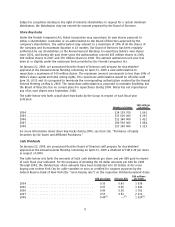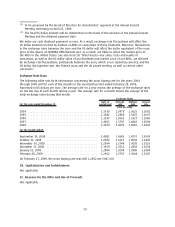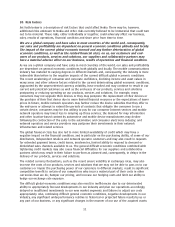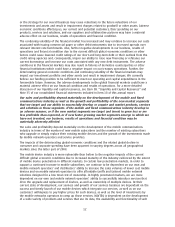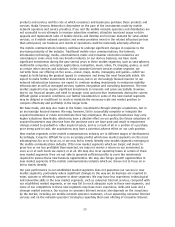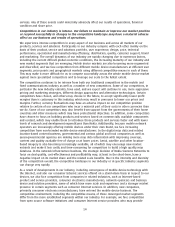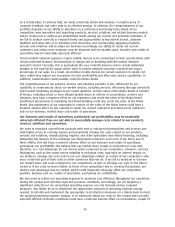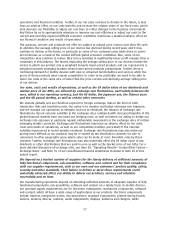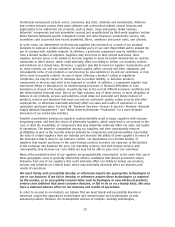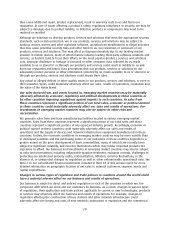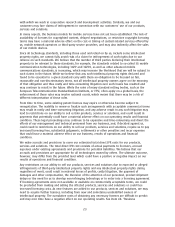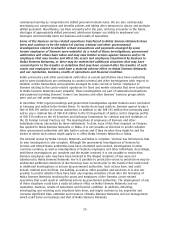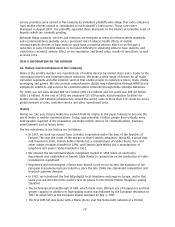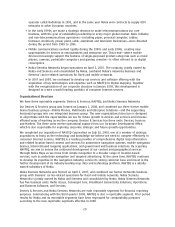Nokia 2008 Annual Report Download - page 20
Download and view the complete annual report
Please find page 20 of the 2008 Nokia annual report below. You can navigate through the pages in the report by either clicking on the pages listed below, or by using the keyword search tool below to find specific information within the annual report.applications and technology platforms for our mobile devices, services and software and networks
infrastructure products involve time, substantial costs and risks, both within and outside of our
control. We must also be able to convert these complex technologies into affordable and usable
products, services and solutions that our current and potential customers prefer over those of our
competitors. This is true regardless of whether we develop these technologies internally, acquire or
invest in other companies with these technologies or collaborate with third parties on the
development of these technologies.
The technologies, applications and technology platforms as well as functionalities, features and
services on which we choose to focus may not achieve or retain as broad or timely market acceptance
as we expect. This may result from numerous factors, including the availability of more attractive
alternatives and a lack of sufficient compatibility with other existing technologies, products, services
and solutions or regulators’ decisions. However, we can only focus on a limited number of
technologies. By choosing to focus on certain technologies, we may forego alternatives achieving
broader acceptance in our overall market or in certain parts of it. Additionally, even if we do select
the technologies, functionalities, features and services that customers ultimately want, we or the
companies that work with us may not be able to bring them to the market at the right time. We may
also face difficulties accessing the technologies preferred by our current and potential customers, or
at prices acceptable to them.
Furthermore, as a result of ongoing technological developments, our products, services and solutions
are increasingly used together with hardware, software or service components that have been
developed by third parties, whether or not we have authorized their use with our products, services
and solutions. However, such components, such as batteries or software applications, may not be
compatible with our products, services and solutions and may not meet our and our customers’
quality, safety, security or other standards. As well, certain components or layers that may be used
with our products may enable our products, services and solutions to be used for objectionable
purposes, such as to transfer content that might be illegal, hateful or derogatory. The use of our
products, services and solutions with incompatible or otherwise substandard hardware, software or
software components, or for purposes that are inappropriate, is largely outside of our control and
could harm the Nokia brand.
Any actual or even alleged defects or other quality issues in our products, services and
solutions could materially adversely affect our sales, results of operations, reputation and the
value of the Nokia brand.
Our products, services and solutions are highly complex, and defects in their design, manufacture and
associated software have occurred and may occur in the future. Quality issues are emphasized in our
devices and services business due to very high production volumes of many of our devices, as a result
of which even a single defect in their design, manufacture or associated software may have a
material adverse effect on our business. Further, our device portfolio is subject to continuous renewal
which, in particular during the periods of large product renewals, may increase the risk of the quality
issues related to our new devices. In the network infrastructure business, the undisturbed functioning
of large mobile and fixed telecommunications networks may depend on the proper functioning of our
products. We make provisions to cover our estimated warranty costs for our products, services and
solutions. We believe that our provisions are appropriate, although the ultimate outcome may differ
from the provided level which could have a positive or negative impact on our results of operations
and financial condition.
Defects and other quality issues may result from, among other things, failures in our own product
creation and manufacturing processes or failures of our suppliers to comply with our supplier
requirements. Prior to the shipment, quality issues may cause failures in ramping up the production
of our products and shipping them to the customers in a timely manner as well as related additional
costs or even cancellation of orders by customers. After shipment, products may fail to meet
marketing expectations set for them, may malfunction or may contain security vulnerabilities, and
19


